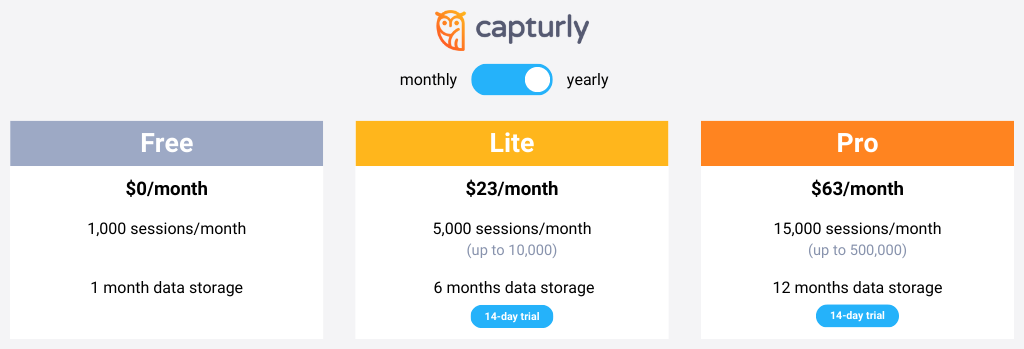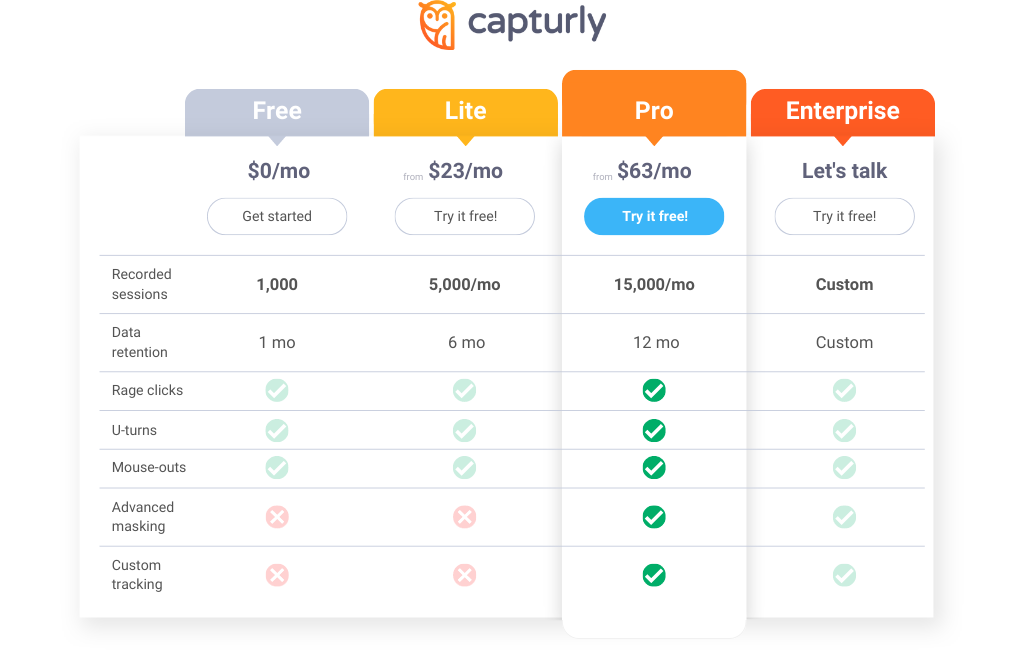In today’s rapidly expanding data analytics landscape, both Capturly and Lucky Orange have established themselves as noteworthy contenders. Each platform offers its unique set of features and capabilities, catering to diverse user needs.
As businesses and individuals grapple with the choice between these two analytics tools, it’s essential to dive deep and understand what sets them apart. This competition analysis aims to provide a detailed, side-by-side comparison of Capturly and Lucky Orange, addressing their strengths, potential areas for improvement, and overall offerings.
Whether you’re a seasoned digital marketer, an entrepreneur, or someone simply curious about the tech world, this article promises to offer clarity and insights. Join us as we embark on this journey, unraveling the distinctiveness of each tool, and helping you make an informed decision for your analytics endeavors.
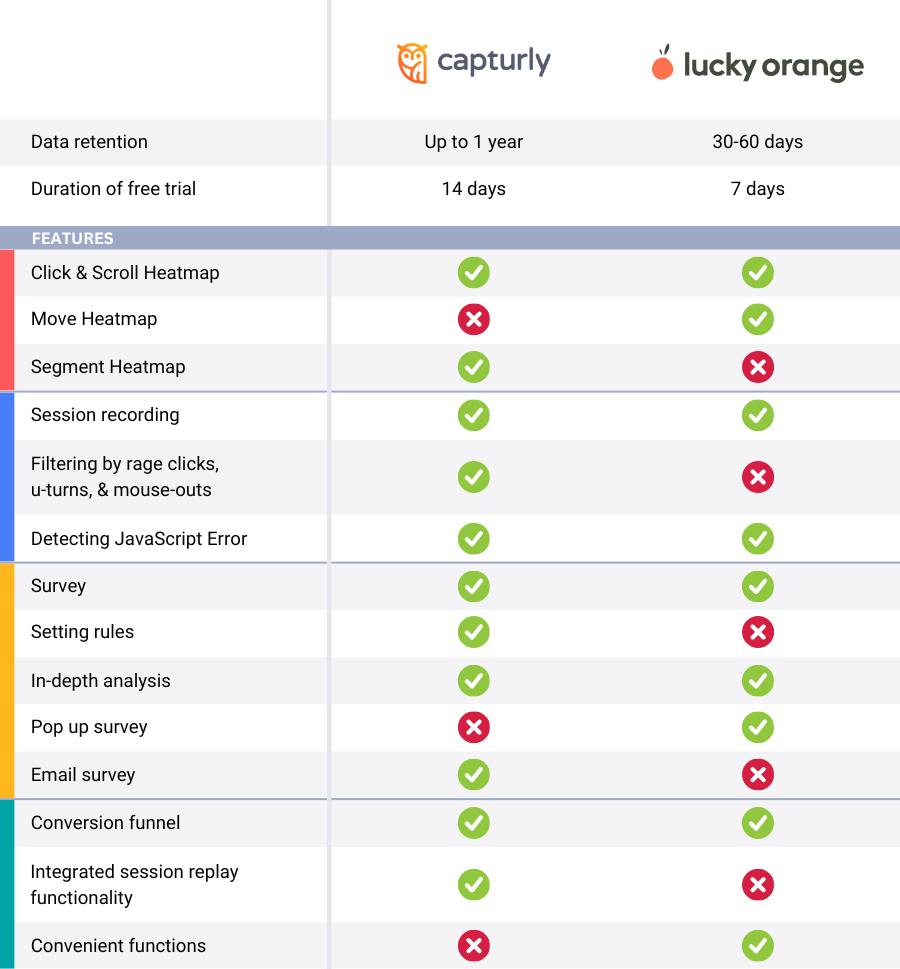
Table of Contents
The story of Capturly
Capturly was established in 2016, and since that time Capturly has worked with hundreds of users and many companies, like Movistar, Proofhub, and Uber.
Capturly’s guiding principle is “Insights speak louder than numbers”, underscoring the depth and quality of services we offer.
Capturly offers a range of services such as heatmaps, session replays, conversion funnels, an analytics platform, surveys, and event analytics.

The story of Lucky Orange
Conversely, Lucky Orange has been around longer than Capturly, having been founded in 2010. Their philosophy is succinctly captured in the phrase, “Less time crunching numbers, more time growing your business.”
Lucky Orange’s offerings include a data analysis tool, featuring dynamic heatmaps, session recordings, conversion funnels, surveys, live chat, dashboard insights, form analytics, visitor profiles, and announcements.
As you can see the two businesses compete with each other in the same field, but they differ from each other slightly in terms of their products.
In this comparison, I’ll focus exclusively on the data analysis tools and methods available from both companies.
Specifically, I’ll be looking at their heatmap services, session recordings, conversion funnels, and survey functionalities.
Given the similarities between their software, I’ll primarily highlight features unique to either Capturly or Lucky Orange.
Let’s take a deep dive into this analysis!

The difference between their heatmap service
While there are many aspects to consider, the heatmap service offered by both companies differs only slightly.
Data retention
One key distinction lies in data retention periods. Data retention refers to the duration for which the service provider stores clients’ data on their servers — essentially, the time frame during which you can access and work with that data.
For this analysis, I looked into the data retention policies of both companies’ premier packages. However, it’s worth noting that both Capturly and Lucky Orange may have customized packages available upon request.
Among their most extensive standard packages, Capturly offers a retention period of 1 year, whereas Lucky Orange provides up to 2 months.
The disparity between these retention periods is significant, and there are clear scenarios where having access to data for a longer duration proves beneficial.
Imagine an A/B testing on your site. It can take up to months, mostly when you still have low traffic.
In such a scenario, users encounter two versions of your site randomly. Concurrently, you monitor their interactions using heatmaps and session replays. Once the test concludes, you assess both versions for user experience and conversion to determine the superior layout.
The process becomes time-sensitive if limited to just a few weeks, without even accounting for potential delays or slowdowns.
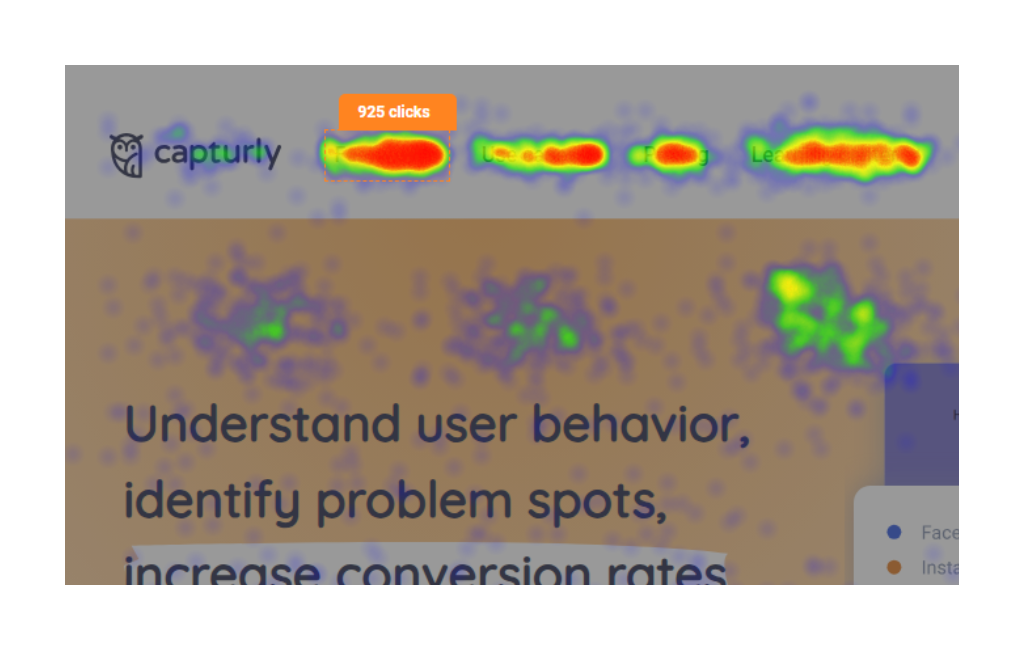
Data sampling
Another distinction between the two arises in their approach to data sampling. Data sampling is a statistical analysis technique where the software assesses a representative subset of data points, extrapolating patterns and trends from this subset to the larger dataset.
In this method, only a selected subset of the data is analyzed, rather than the entirety of it.
While Lucky Orange employs this method, Capturly takes a different approach by analyzing the entirety of the provided data before drawing conclusions.
Often, both methods yield similar outcomes. However, when analyzing user behavior, data sampling may not be as precise as a comprehensive analysis of all data.
Unique heatmaps
An intriguing aspect of both companies’ heatmap services is that each offers a unique heatmap feature that the other lacks.
First, let’s start with Capturly’s option. Capturly provide the users with a segment heatmap.
In this option, you have the opportunity to segment different elements and watch the difference between them. For instance, you might want to see if users from different browsers engage with your content similarly.
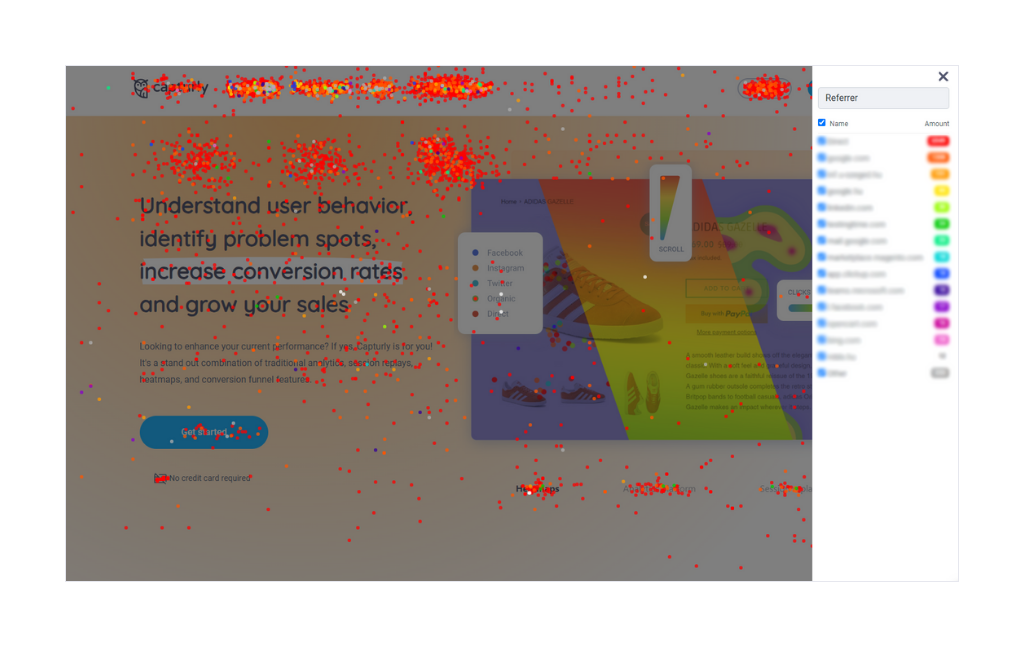
This tool generates a heatmap, employing varied colors to show where users from distinct browsers typically click. This can highlight significant discrepancies, such as when a specific browser interacts differently with a Call-to-Action or fails to respond.
On the other hand, Lucky Orange offers a move heatmap.
Move heatmaps monitor mouse movements. Extensive research indicates that mouse movement often mirrors eye movement. Thus, this data can offer insights into which sections of an article draw attention or which parts of the site are particularly engaging.
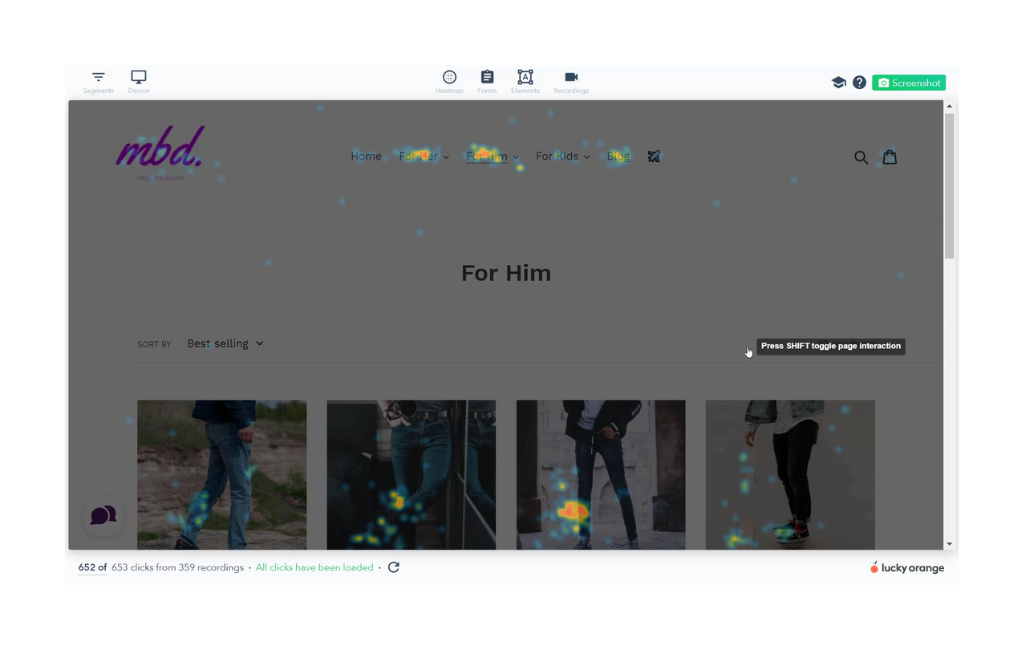
Comparing their session replay service
Both companies have developed versatile session replay tools that encompass all the essential features users demand.
However, when delving deeper into the comparison, Capturly’s session replay tool emerges as slightly more detailed.
Let’s begin by examining the shared features.
Both session replay tools are equipped to track and analyze clicks, rage clicks, u-turns, events, and goals.
Building on this, both Capturly and Lucky Orange offer a rich array of filtering options, enabling you to pinpoint the specific session replays relevant to your particular needs.
In addition to basic filtering options, such as technological attribute filtering, session attribute filtering, and behavioral filtering, both companies provide even more nuanced tools.

Filtering options both Capturly and Lucky Orange have
Both tools offer a path-filtering feature. Here, you can filter sessions based on the path your visitors took, including the specific page(s) they visited, landed on, or exited from. Additionally, you have the option to hide bounce visits, ensuring a more focused analysis.
Capturly and Lucky Orange may ensure you a wide range of demographic filtering if the situation demands it – that is the user attribute filtering. In this function, both tools allow you to filter sessions based on user attributes such as the country from which the user is browsing your page. This helps you gain insights specific to different geographic regions.
Detecting Javascript errors
Both Capturly and Lucky Orange possess the capability to detect JavaScript errors. Admittedly, JavaScript errors can be daunting and perplexing initially. In this segment, I’ll delve deeper to unravel these intricacies.
There are two primary categories of JavaScript errors:
- Syntax Errors: These are often the result of missing characters or typographical errors within the code.
- Runtime Errors: These occur when the script struggles to execute a particular command or instruction.
Although such events are infrequent, the majority of them might go unnoticed, leaving the user experience unscathed. However, occasionally, under specific conditions—like using a non-standard browser, a unique device, or an unusual timezone—a significant issue can manifest.
Consider this scenario: A user, one of the few remaining loyalists of the Blackberry brand, accesses your website. While this brand’s phones might be a rarity today, they are still in use.
Now, this user begins exploring your offerings and identifies a product that aligns perfectly with their requirements. They eagerly tap on the “buy now” button, yet nothing transpires. After multiple fruitless attempts, exasperation kicks in, and they abandon your website.
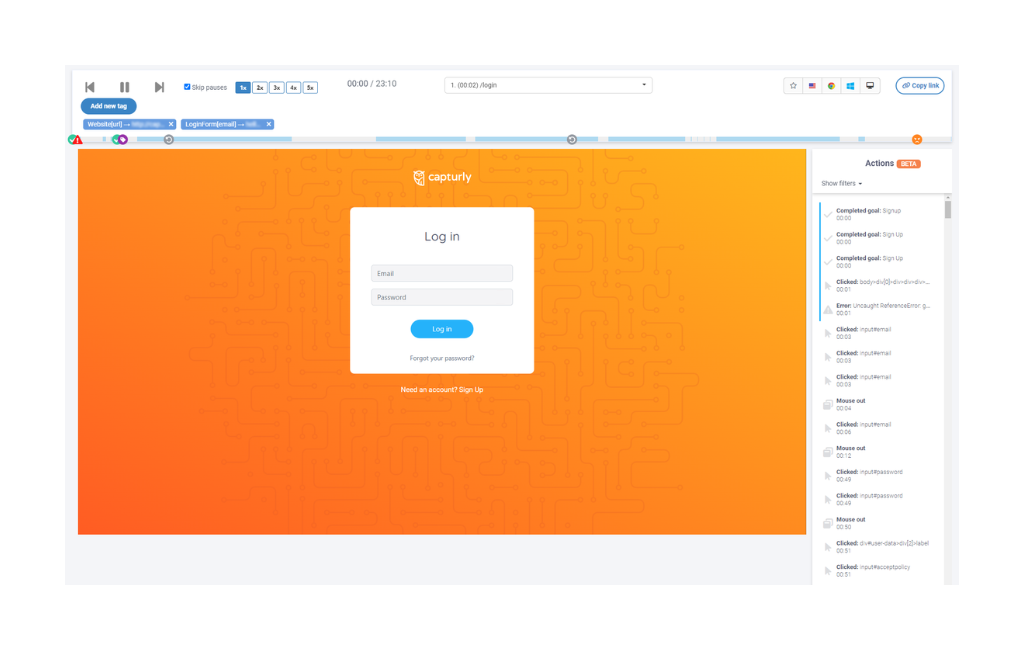
In the aftermath of this unfortunate occurrence, you scrutinize the session replay using Capturly’s toolset. The system pinpoints a JavaScript error, prompting you to sift through various metrics to ascertain the root cause. During this investigative process, you discern another user encountering a similar roadblock, attributed to the same Blackberry device.
Recognizing this, you promptly refine your website to accommodate this specific device, thereby resolving the issue.
The difference between their survey options
Surveys were not a crucial part of data analysis companies in the past, but that has changed.
Companies have realized the value of customer feedback and are making greater efforts to gather information from their users.
Additionally, many businesses grapple with the same question: How can they enhance the user experience?
Measuring customer preferences and redesigning the site based on this feedback can significantly improve the user experience.
Lucky Orange introduced this function several years ago, and it has undergone numerous positive changes since then.
In contrast, Capturly has recently introduced this as a new function, which is currently in beta testing.
It might seem that Capturly needs more time to match Lucky Orange’s proficiency with surveys, but that’s not necessarily true.
The beta version of Capturly’s survey function even has some benefits which are not included in Lucky Orange’s version. As you will soon see firsthand, the ability to set rules offers a remarkable advantage!
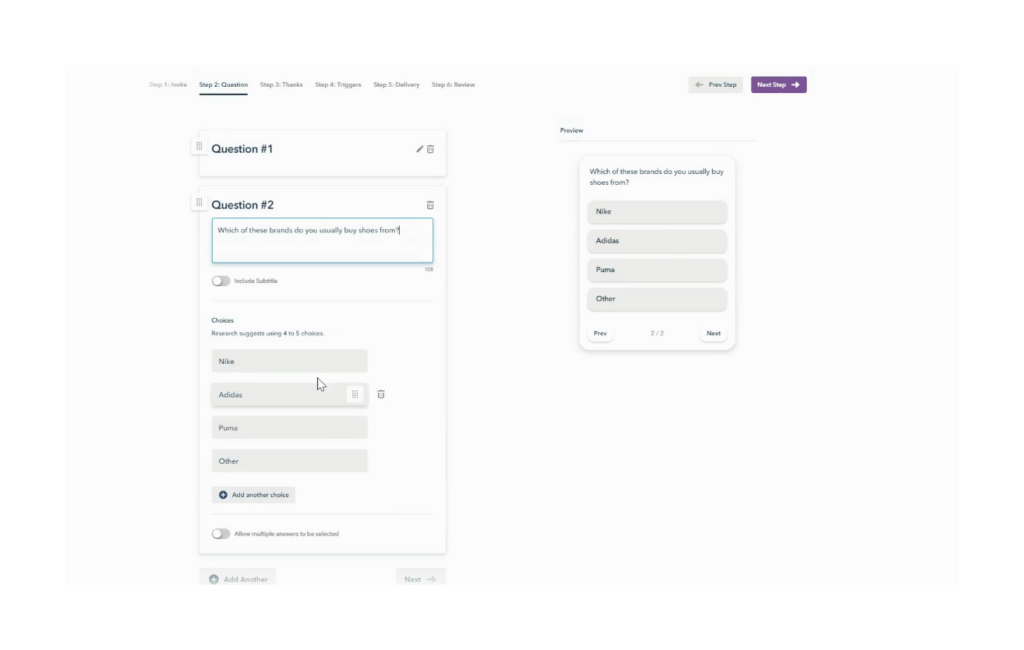
Setting rules
Don’t worry if you don’t know much about this function, I show this through an example:
Imagine the question: “Were you glad to use our service? – Answer on a 1-10 scale, where 1 means that it was terrible, 10 means it was fantastic.”
Based on this question, you can calculate an average score to gauge your customers’ satisfaction with your service. But you need two more things to increase user experience and learn from your own mistakes.
- Say thank you to all who gave you an extra high score – They can easily be transformed into very loyal customers
- Ask from the disappointed customer – This will help you to improve, and calm the customers that you care about their issues.
This approach requires categorizing the responses into two distinct groups.
This is where ‘rules’ come into play. Set a rule that if the answer is above 8, the customer is directed to a ‘thank you’ page. Conversely, if the answer is below 3, prompt them with, “Can you share the reason for your dissatisfaction with our site?”.
This is a feature that Capturly offers, but currently, Lucky Orange does not.
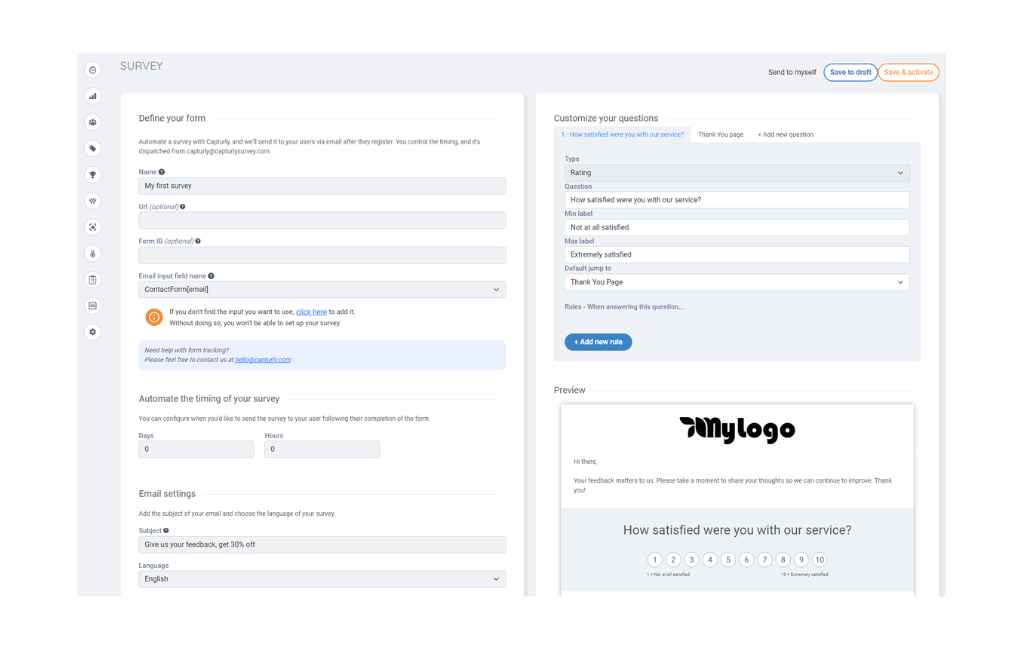
In-depth analysis
Both companies offer comprehensive in-depth analysis tools for their surveys.
This implies that both tools provide statistical data derived from the completed surveys. This includes the response rate (the percentage of recipients who completed the survey) and the total number of visitors reached.
Additionally, Lucky Orange boasts a unique feature termed ‘average time to start the filling process. As the name suggests, this feature indicates the duration users take before they begin interacting with the survey forms.
Differences in survey distribution locations
Obtaining feedback from your visitors or buyers doesn’t always mean they can be reached directly on your website.
At times, reaching out on a different platform can be more efficient and yield higher response rates.
That’s why Capturly offers the option of either on-site or email surveys.
In contrast, Lucky Orange lacks this functionality in its toolset.
The differences in their conversion funnel tools
Conversion funnel analysis is pivotal for data analytics tools, as it highlights the success rates of specified sub-goals and the primary objectives set by a company.
To effectively chart user progress toward completing a goal, a customizable funnel is essential, allowing for the integration of the required URLs.
A robust conversion funnel analysis showcases distinct graphics for each step, ensuring clear differentiation and easily identifiable bounce rates.
Indeed, both tools effectively meet these criteria.
However, distinctions exist between them.
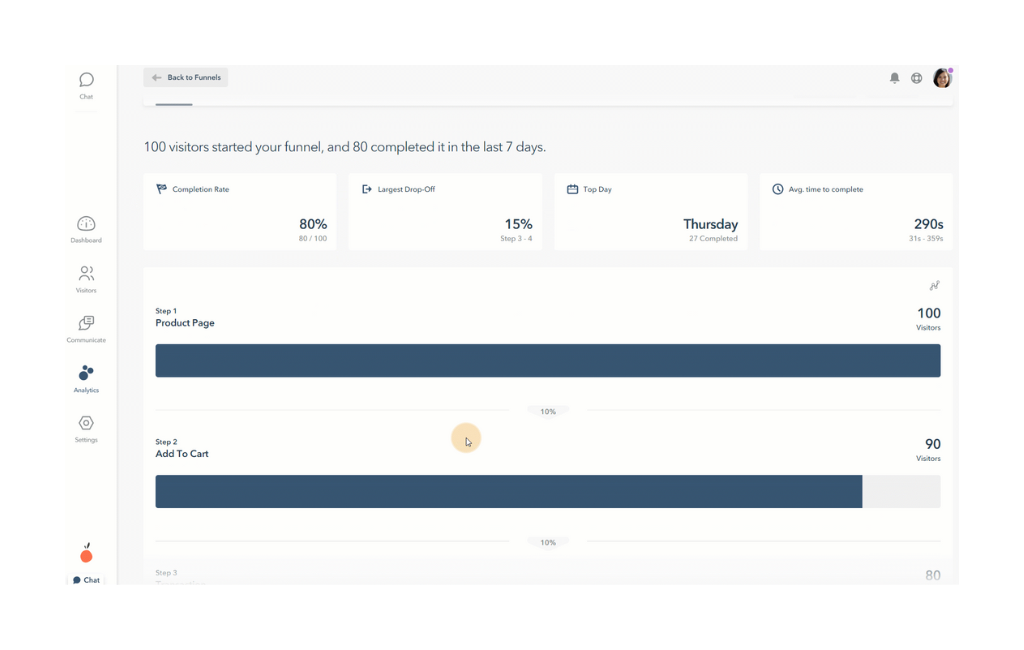
Integrated session replay functionality
Capturly, for instance, has seamlessly integrated its session replay tool with the conversion funnel tool, and the result is commendably efficient.
Wondering how it operates? Allow me to illustrate.
Consider a typical conversion funnel pathway: main page (1000 users) → plan page (950 users) → registration process (50 users) → completed registration (30 users).
Imagine 1000 unique users landing on the main page, of which only 30 complete the registration. This equates to a 97% bounce rate. However, the intriguing part is the staggering 94.7% bounce rate between the plan page and the registration process.
Thus, of the entire 1000 users journeying through the funnel, 900 drop off between these two crucial steps.
Given that the software enumerates all sessions terminating between these steps, it becomes straightforward to pinpoint significant flaws. Without the session replay tool’s integration, one could still tackle this challenge, albeit less efficiently.

Convenient functions
Lucky Orange offers a range of user-friendly features. While they might not be as transformative as Capturly’s integrated tools, they certainly offer time-saving benefits.
These features include a display that highlights the top-performing conversion funnel for each day and the average duration users took to complete it. Furthermore, the software dispatches a weekly analysis directly to users’ emails, detailing the performance metrics of each funnel.
Capturly’s pricing
Capturly offers a range of four distinct packages, and depending on the desired number of session recordings, there’s a vast array of choices available.
Customers have two billing options: monthly and yearly. If one breaks down the yearly billing into 12 parts, it’s more economical than the monthly subscription across a full year. To simplify, I’ll use the monthly billing rates for our comparison.
Starting with the basic tier, the Lite package, priced at $29 a month, offers the following:
- Access to 3 funnels
- Unlimited heatmaps
- 6-month data retention
- 5,000 recorded sessions
- Additional features like email tagging and custom tagging
For larger businesses, Capturly’s Pro package is priced at $79 a month and boasts:
- 12 months of data retention (among the market’s longest offerings)
- Unlimited access to heatmaps and funnels
- A generous 15,000 recorded sessions per month
- Valuable extras, including email and custom tagging, rule settings, and advanced masking
- For businesses with needs exceeding the Pro package, the Enterprise option allows for personalized negotiations on rates and offerings.
This tier provides the flexibility to curate a package that aligns perfectly with specific requirements. Beyond access to all premium services, subscribers also benefit from dedicated support, ensuring a seamless experience.
Lucky Orange’s pricing
Lucky Orange’s pricing strategy deviates slightly from Capturly’s. They offer a spectrum of five distinct packages, aside from their free option. A standout feature is that all extra options are consistently present across their packages.
The distinguishing factor among their plans lies in the number of session views a customer can access.
Starting with their initial paid offering, the ‘Build’ plan is priced at $40 monthly. Subscribers benefit from:
- Viewing up to 5,000 sessions each month
- All supplementary features as highlighted earlier
Following this, their subsequent plans are the “Grow”, “Expand”, and “Scale” tiers. Here’s a breakdown:
- Grow Plan: Priced at $79 a month, it grants:
- Access to 15,000 sessions monthly
- Expand Plan: At $179 monthly, subscribers get:
- A substantial 45,000 session views each month
- Scale Plan: The premium offering, costing $749 a month, unlocks:
- A whopping 300,000 sessions per month

Comparing their value/price ratio
Determining value for money is one of the most challenging aspects of this comparison. However, one thing stands out clearly: Capturly’s plans are more affordable than those of Lucky Orange.
When we juxtapose Capturly’s Pro version with Lucky Orange’s Growth plan, we find they are priced similarly. Intriguingly, while this represents one of Capturly’s premium offerings, it’s only the second-tier plan for Lucky Orange.
The distinctiveness doesn’t lie in the number of session replays, as both packages from the companies offer 15,000 per month. However, the disparity in data retention is striking: Capturly guarantees 12 months, whereas Lucky Orange provides just 2 months.
Shifting our focus, let’s delve into the offerings of their complimentary plans!
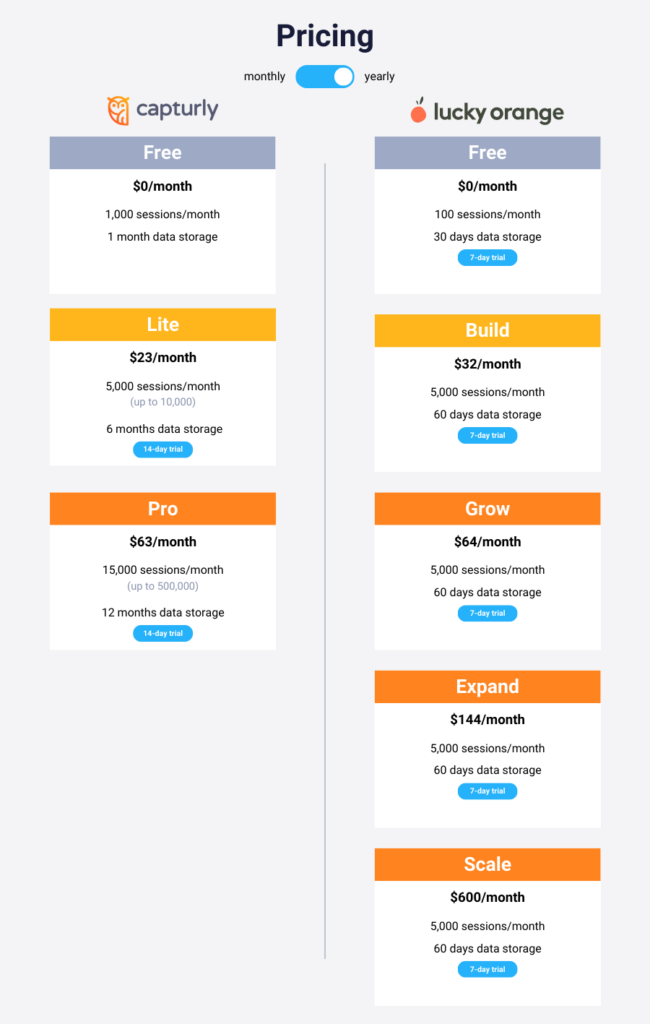
Comparing their free packages
Both tools have unique strengths when it comes to their free offerings.
Capturly takes the lead in terms of volume, offering a generous 1,000 sessions with a 60-day data retention period in their complimentary plan. These figures are notable and surpass what Lucky Orange offers, which is a more modest 100 sessions per month with a 30-day data retention period.
However, Lucky Orange has its own edge. All of the tool’s auxiliary features are accessible in its free package, encompassing unlimited conversion funnels, custom event tracking, and more. Capturly, in contrast, doesn’t extend these functionalities to users of its free version.
Conclusion
Throughout this detailed examination, I have ventured to compare and contrast the nuances of Capturly and Lucky Orange as data analyzer software platforms.
While the race was neck-and-neck, with little separating the two in terms of capabilities, Capturly manages to inch ahead in the competition.
So, why do I lean towards Capturly? Why might you consider Capturly over Lucky Orange?
✅ Extended Data Retention: Capturly provides a longer data retention period.
✅ Advanced Survey Customization: Capturly offers a rule setting for surveys, enabling the creation of more intricate feedback mechanisms.
✅ Integrated Toolset: The seamless integration between the conversion funnel analyzer and session recording in Capturly translates to time efficiency.
✅ Competitive Pricing: Capturly is slightly more budget-friendly.
These elements make a compelling case for Capturly’s slight edge in the market.
Don't forget, sharing is caring! :)


